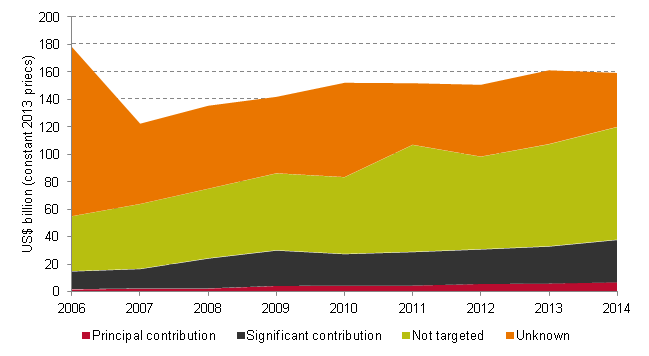The proportion of aid that is specifically targeted at gender remains low
The ambition to address global gender inequality is at the heart of the 2030 Agenda for Sustainable Development and the commitment to leave no one behind. Global Goal 5 seeks to “achieve gender equality and empower all women and girls”.
In order to track the extent that donors are delivering on global policy commitments on gender equality, reporting on gender-related spending is critical. Reporting on such spending through the OECD DAC’s gender equality policy marker has improved over recent years. The proportion of total official development assistance (ODA, commonly known as aid) coded with the marker has increased steadily from 52% in 2008, when the gender policy marker was established, to a high of 75% in 2014.
However, while reporting may be improving, the proportion of projects specifically targeted at gender has remained low, constituting a fifth of all aid. The combined proportion of ODA making a ‘significant’ or ‘principal’ contribution to gender equality in 2009 was 21%, falling slightly in 2010 to 18%, and has since only incrementally increased, standing at 23% in 2014. This is less than half of the 52% marked as not targeting gender equality (marked 0) in 2014.
Gender relevance of ODA as reported using the gender quality policy marker, 2006−2014
Source: OECD DAC Creditor Reporting System
To ensure that Agenda 2030’s ambition to leave no-one behind is realised, Global Goal 5 on achieving gender equality and empowering all women and girls must be met. For this, it is critical that the following three points are achieved:
- Adequate funding should be targeted specifically at gender equality. This necessitates the mobilisation of resources beyond aid – including those that are public, private, international and domestic.
- Gender-disaggregated data should be available at national and sub-national levels to ensure that such funding is targeted effectively towards addressing the different needs of women, girls, men and boys.
- Donor reporting on gender-related spending continues to improve and plays a critical role in tracking the delivery of gender-related policy commitments and strengthening transparency and accountability. Whilst there are some shortcomings with OECD DAC’s gender policy marker – particularly regarding the need to systematically review the application of the gender marker throughout the programme cycle – it does provide a standardised and systematic tool for tracking and comparing donor spending on gender. A mandatory commitment from all donors to use this marker would help to strengthen reporting and transparency of resource targeting to gender equality.
Note: This blog uses the Organisation for Economic Co-operation and Development (OECD) Development Assistance Committee (DAC)’s gender equality policy marker. Principal (marked 2): gender equality is the main objective of the activity and that activity would not have been undertaken without this objective. Significant (marked 1): gender equality is an important but secondary objective. Not targeted (marked 0): the activity has been screened using the gender equality policy maker and does not target gender equality. Unknown (left blank): a gender equality policy marker (2−0) has not been applied.
Related content
Priorities for the UK’s incoming Secretary of State Alok Sharma
As Alok Sharma takes office as Secretary of State, DI's Amy Dodd sets out key priorities for the UK and its global development agenda.
From review to delivery on the Global Goals – what should the immediate priorities be for the UK government?
On 26 June, the UK government published its Voluntary National Review measuring delivery against the Global Goals - but does it accurately capture progress?
Three priorities for the High-level Political Forum 2019
DI Director of Partnerships & Engagement Carolyn Culey sets out three key priorities for closing the gap between the poorest and the rest at HLPF 2019
